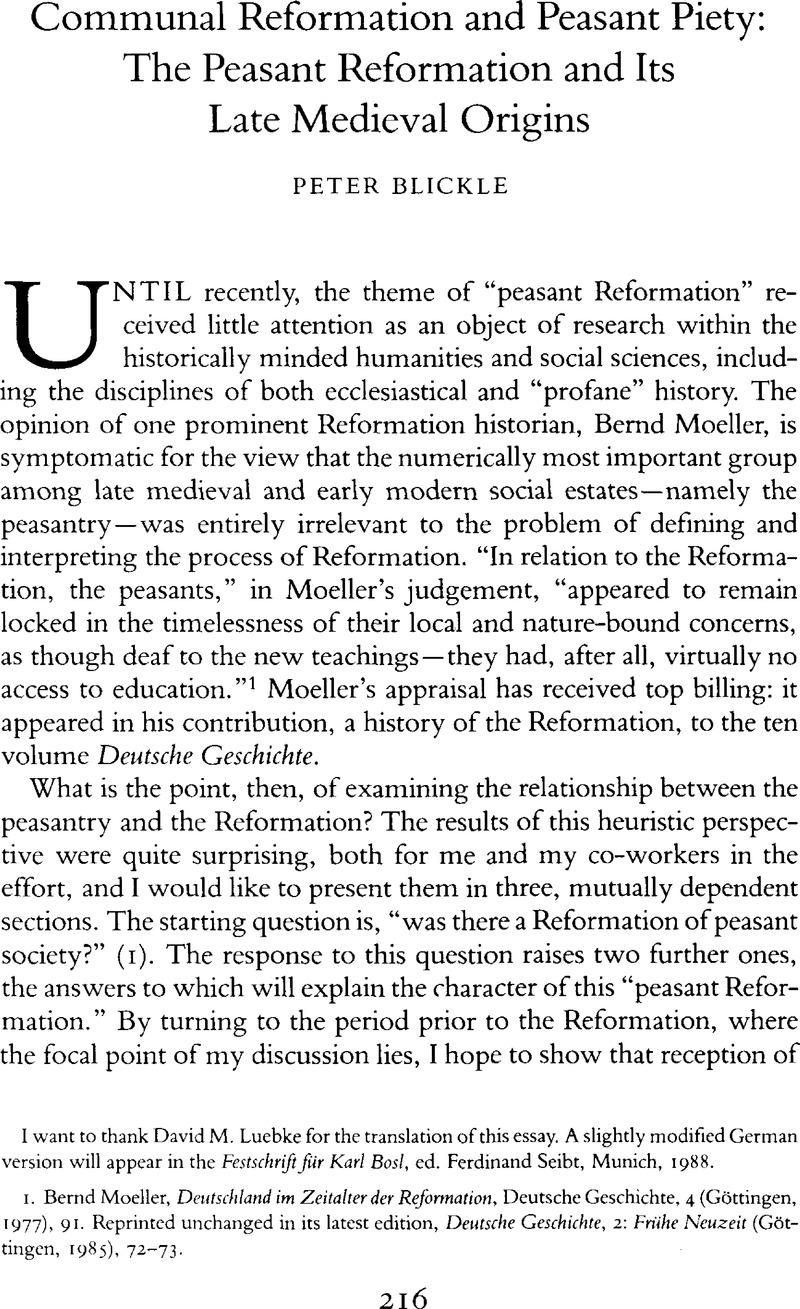Article contents
Communal Reformation and Peasant Piety: The Peasant Reformation and Its Late Medieval Origins
Published online by Cambridge University Press: 16 December 2008
Abstract

- Type
- Symposium Reformation and Revolution: From the Sacral Community to the Common Man
- Information
- Copyright
- Copyright © Conference Group for Central European History of the American Historical Association 1987
References
I want to thank M., David Lueblce for the translation of this essay. A slightly modified German version will appear in the Festschriftfiir Karl Bosl, ed. Ferdinand Seibt, Munich,1988Google Scholar.
1. Moeller, Bernd, Deutschland im Zeitalter der Reformation, Deutsche Geschichte, 4 (Göttingen, 1977). 91Google Scholar. Reprinted unchanged in its latest edition, Deutsche Geschichte, 2: Frühe Neuzeit (Göttingen, 1985), 72–73.
2. Support for the interpretations presented here is to be found primarily in Blickle, Peter, Gemeindereformation: Die Menschen des 16. Jahrhunderts auf dem Weg zum Heil (Munich, 1985; Studienausgabe, 1987), 24–76.Google Scholar
3. Bierbrauer, Peter, “Die Reformation in den Schaffhauser Gemeinden Hallau und Thayngen,” in Blickle, Peter, ed., Zugänge zur bäuerlichen Reformation, Bauer und Reformation, 1 (Zurich, 1987), 38Google Scholar, and P. Kamber, “Die Reformation auf der Zürcher Landschaft am Beispiel des Dorfes Marthalen,” ibid., 86.
4. These geographical estimates, which are based on published documents, have been elaborated by regional and local case-studies. See von Rütte, Hans, “Bäuerliche Reformation am Beispiel der Pfarrei Marbach im sanktgallischen Rheintal,” in Blickle, , ed., Zugänge, 55–84Google Scholar, Conrad, Franziska, Zur Rezeption reformatorischer Theologie im Elass, Veröffentlichungen des Instituts für europäische Geschichte Mainz, 116 (Mainz, 1984)Google Scholar, and Endres, Rudolf, “Die Reformation im fränkischen Wendelstein,” in Blickle, , ed., Zugänge, 127–46.Google Scholar
5. For individual examples see Blickle, Gemeindereformation, 50ff. Communal Reformation and Peasant Piety
6. Blickle, , Gemeindereformation, 68–71Google Scholar. For a closer argumentation of this point, supported by more concentrated evidence, see Blickle, Peter, “Die soziale Dialektik der reformatorischen Bewegung,” in Blickle, , Lindt, Andreas and Schindler, Alfred, eds., Zwingli und Europa: Referate und Protokoll des International en Kongresses aus Anlass des 500. Geburtstages von Huldreich Zwingli (Zurich, 1985), 71–89.Google Scholar
7. Von Rütte, “Marbach,” 71, and Blickle, Gemeindereformation, 58–59.
8. For a more detailed discussion of the various points of convergence and divergence between the Reformation concept of peasants and that of the Reformers see Blickle, , Gemeindereformation, 123–64.Google Scholar
9. Bierbrauer, Peter, Die Reformation in Tirol (forthcoming in 1989), 128.Google Scholar
10. Blickle, Peter et al. , “Zürichs Anteil am deutschen Bauernkrieg: Die Vorstellung des göttlichen Rechts im Klettgau,” Zeitschrift für die Geschichte des Oberrheins 133 (1985): 93ff.Google Scholar
11. Blickle, , Gemeindereformation, 167–204.Google Scholar
12. Blickle, , “Soziale Dialektik,” 78.Google Scholar
13. This section is based primarily on the work of Fuhrmann, Rosi, “Die Kirche im Dorf: Kommunale Initiativen zur Organisation der Seelsorge vor der Reformation,” in Blickle, , ed., Zugänge, 147–86Google Scholar, von Rütte, “Marbach.”
14. Rütte, Von, “Marbach,” 74–75.Google Scholar
15. von Rütte, Hans, “Von der spätmittelalterlichen Frömmigkeit zum reformierten Glauben: Kontinuität und Bruch in der Religionspraxis der Bauern,” Itinera 8 (1988): 33–44.Google Scholar
16. Fuhrmann, , “Kirche im Dorf,” 155.Google Scholar
17. ibid., 169–79.
18. ibid., 172.
19. ibid., 177ff.
20. ibid., 179.
21. Rütte, Von, “Marbach,” 82Google Scholar, and Fuhrmann, , “Kirche im Dorf,” 185.Google Scholar
22. Fuhrmann, , “Kirche im Dorf,” 157, 166,Google Scholar and Rütte, von, “Marbach,” 73.Google Scholar
23. Blickle, , Gemeindereformation, 110–22.Google Scholar
24. Schmidt, Heinrich R., “Die Häretisierung des Zwinglianismus im Reich seit 1525,” in Blickle, , ed., Zugänge, 219–36, here 230.Google Scholar
25. ibid., 235.
26. Delumeau, Jean, Le catholicisme entre Luther et Voltaire, Nouvelle Clio, 30 bis (Paris, 1971)Google Scholar. This entire direction of research has recently been criticized by Wirth, J., “Against the Acculturation Thesis,” in von Greyerz, Kaspar, ed., Religion and Society in Early Modern Europe, 1500–1800 (London, 1984), 66–78.Google Scholar
- 5
- Cited by




